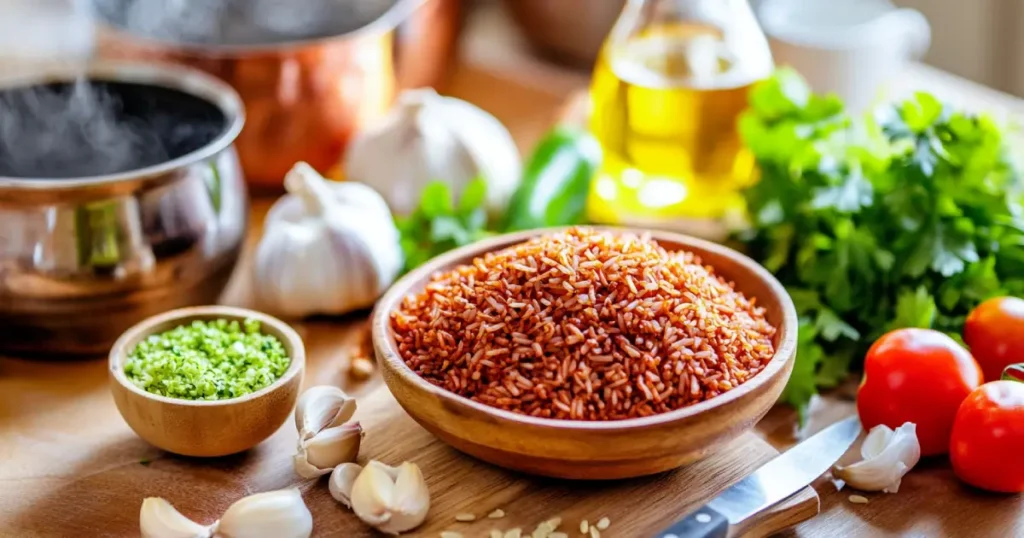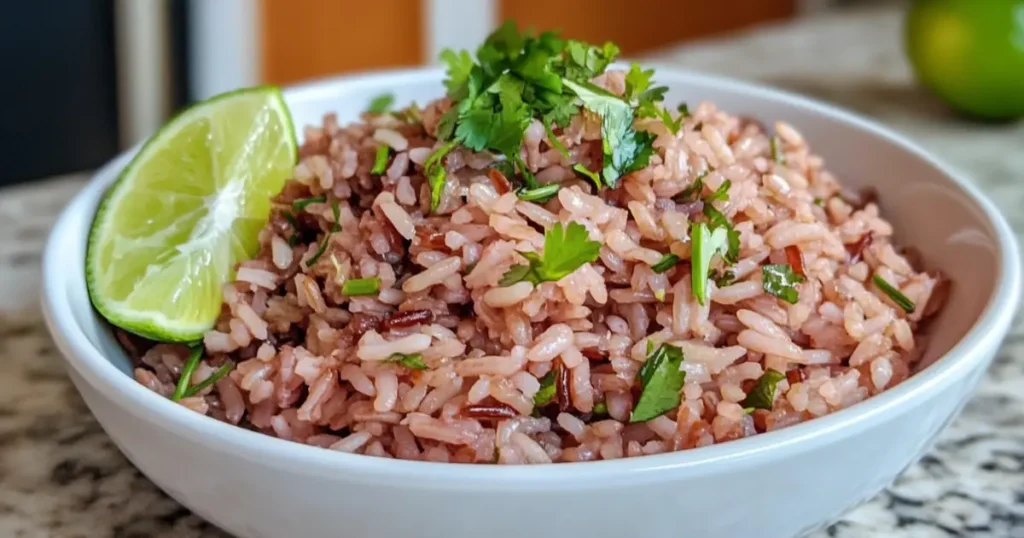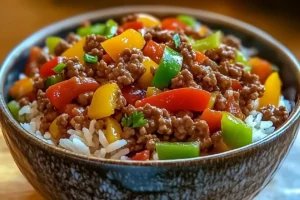Red rice, a nutrient-packed grain, is more than just a staple food—it’s a journey into the heart of wholesome cooking. From its earthy flavor to its vibrant hue, red rice has carved a special place in culinary traditions worldwide. In this article, we’ll explore everything you need to know about red rice recipes: the history, health benefits, cooking techniques, and exciting dishes you can whip up to impress your family and friends. Whether you’re a seasoned chef or a beginner, this guide will help you master the art of cooking red rice.
Outline
Introduction to Red Rice
What is Red Rice?
Red rice is a whole grain rice variety that boasts a reddish-brown hue due to its high anthocyanin content. This natural pigment is not just for show—it’s a potent antioxidant that adds to the nutritional appeal of red rice. Unlike polished white rice, red rice retains its bran layer, making it a nutrient-dense option packed with fiber, vitamins, and minerals.
Historical and Cultural Significance
The history of red rice dates back centuries, particularly in Asian and African cuisines. It has been a dietary staple in regions like India, Thailand, and Madagascar, where it symbolizes prosperity and good health. In the southern United States, Charleston Red Rice is a beloved dish that reflects the rich Gullah-Geechee culinary heritage, blending African, Caribbean, and American influences.
Nutritional Value of Red Rice
Red rice is a powerhouse of nutrition. High in fiber, it promotes better digestion and helps maintain healthy cholesterol levels. It’s also a rich source of iron, which supports red blood cell production, and magnesium, essential for muscle and nerve function. With a low glycemic index, red rice is an excellent choice for individuals managing diabetes or aiming for steady energy levels throughout the day.
Benefits of Cooking with Red Rice
Health Benefits of Red Rice
One of the standout reasons to explore a red rice recipe is the health boost it offers. Red rice is rich in antioxidants, particularly anthocyanins, which are known to fight free radicals and reduce inflammation. This means it may help lower the risk of chronic diseases like heart disease and certain types of cancer.
Additionally, red rice is a fantastic source of dietary fiber, which promotes better digestion and keeps you feeling full longer. This can be a big help if you’re trying to manage your weight. Plus, its low glycemic index makes it a smart choice for maintaining steady blood sugar levels, especially for those with diabetes.
Why Choose Red Rice Over White Rice?
You might wonder, “Why not just stick with white rice?” Well, red rice has a leg up when it comes to nutrition. Unlike white rice, which is stripped of its bran and germ layers, red rice retains these nutrient-rich components. That means you get more magnesium, iron, and B vitamins in every bite.
What’s more, red rice has a naturally nutty flavor and a satisfying chewy texture that enhances a wide range of dishes. Whether you’re creating a hearty salad, a vegan-friendly stir-fry, or a comforting bowl of Southern-style red rice, this grain packs both flavor and nutrition.
How to Cook Perfect Red Rice

Step-by-Step Guide to Cooking Red Rice
Cooking red rice can seem intimidating at first, but it’s simpler than you think. Here’s a foolproof method to nail the perfect red rice recipe every time:
- Rinse the Rice: Start by rinsing the red rice thoroughly under running water to remove excess starch.
- Soak for Better Texture: Soaking the rice for 30 minutes softens the grain and reduces cooking time.
- Choose Your Cooking Method:
- Stovetop: Use a 1:2 ratio of rice to water. Bring to a boil, then simmer on low heat for 30-40 minutes.
- Rice Cooker: Add the rinsed rice and water, then select the brown rice or whole grain setting.
- Pressure Cooker: Cook on high pressure for about 20 minutes, followed by natural pressure release.
Common Mistakes to Avoid When Cooking Red Rice
- Skipping the Soak: If you don’t soak red rice, you might end up with unevenly cooked grains.
- Using Too Much Water: Unlike white rice, red rice requires precise water-to-rice ratios to avoid sogginess.
- Rushing the Process: Red rice takes longer to cook, so patience is key to achieving its signature chewy texture.
Red Rice for Beginners: Easy Recipes to Try
Quick and Simple Red Rice Pilaf
For an easy and healthy side dish, a red rice pilaf is hard to beat. Simply sauté diced onions, garlic, and your choice of vegetables. Add rinsed red rice and cook in vegetable broth until tender. Finish with a sprinkle of fresh parsley.
Healthy Red Rice Salad
This cold salad is perfect for meal prep or a light lunch. Toss cooked red rice with chopped cucumbers, cherry tomatoes, olives, and feta cheese. Dress it with olive oil, lemon juice, and oregano for a Mediterranean twist.
Vegan-Friendly Red Rice Bowl
Build a satisfying vegan meal with this bowl-based recipe. Layer cooked red rice with roasted sweet potatoes, steamed broccoli, and chickpeas. Drizzle with tahini dressing for a creamy, plant-based delight.
For more recipe ideas, check out other delicious dishes .
Tips and Tricks for Enhancing Red Rice Dishes
Adding Proteins and Vegetables for Balanced Meals
To turn your red rice recipe into a complete meal, add lean proteins like chicken, shrimp, or tofu. Incorporating vegetables such as bell peppers, zucchini, or spinach boosts the dish’s nutrient content and visual appeal. Stir in sautéed veggies right before serving for the best texture.
Seasoning Ideas for Maximum Flavor
For richer flavors, cook red rice in vegetable or chicken stock instead of plain water. Adding a splash of coconut milk during cooking creates a creamy base that complements spicy or sweet toppings. Don’t forget a garnish of fresh herbs like cilantro or parsley to brighten the dish.
By following these tips, you’ll elevate any red rice recipe into a standout dish that’s both delicious and nutritious. Let me know if you’d like to develop additional recipes or visuals!
FAQs
How is Red Rice Made?
Red rice is a whole grain variety with its bran layer intact, giving it its distinctive reddish hue. It’s cultivated primarily in regions with warm climates, such as Asia and Africa. The color comes from anthocyanins, a type of antioxidant found in the bran. To prepare red rice for eating, the grains are typically washed, soaked, and then cooked using methods like boiling, steaming, or pressure cooking, often with a 1:2 rice-to-water ratio.
Is Red Rice Really Good for You?
Yes, red rice is highly nutritious and offers several health benefits. It is rich in fiber, which supports digestion, and antioxidants, like anthocyanins, which help fight inflammation and protect against chronic diseases. Additionally, it contains iron and magnesium, essential for energy production and muscle health. Red rice has a low glycemic index, making it an excellent option for people managing diabetes or trying to maintain stable blood sugar levels.
Should Red Rice Be Soaked Before Cooking?
Yes, soaking red rice before cooking is recommended. Soaking the grains for 30 minutes to a few hours helps soften the outer bran layer, resulting in a more even texture and reduced cooking time. It also enhances the rice’s digestibility and nutrient absorption. This step is especially helpful if you’re preparing a chewy or tender dish like a red rice recipe.
What is Red Rice in South Carolina?
In South Carolina, red rice refers to Charleston Red Rice, a beloved dish with roots in the Gullah-Geechee culture. This traditional recipe combines red rice with smoky pork, tomatoes, onions, and flavorful spices. It reflects the region’s African and Caribbean culinary influences and is a staple in Southern cuisine, often served as a side dish or a main course. It’s a flavorful way to celebrate both heritage and the unique taste of red rice.
In Closing
Red rice is more than just a nutritious grain; it’s a versatile ingredient that adds depth, flavor, and vibrant color to your meals. From the classic Charleston red rice recipe to quick, beginner-friendly dishes like pilafs and salads, there’s no shortage of ways to incorporate this wholesome grain into your diet. Its rich nutritional profile—packed with fiber, antioxidants, and essential minerals—makes it an excellent choice for anyone looking to eat healthier while savoring delicious meals.
Whether you’re seeking a hearty, comforting dish or a light, refreshing salad, red rice adapts beautifully to a variety of cuisines and flavors. By using the tips and recipes shared in this guide, you can confidently create meals that not only taste amazing but also nourish your body.
So why not start experimenting with a red rice recipe today? With a little creativity and the right ingredients, you’ll discover why this ancient grain has stood the test of time in kitchens around the world.
For more inspiring recipes and cooking tips, be sure to explore additional ideas and resources. Happy cooking!




1 thought on “Red Rice Recipe You’ll Love to Try”